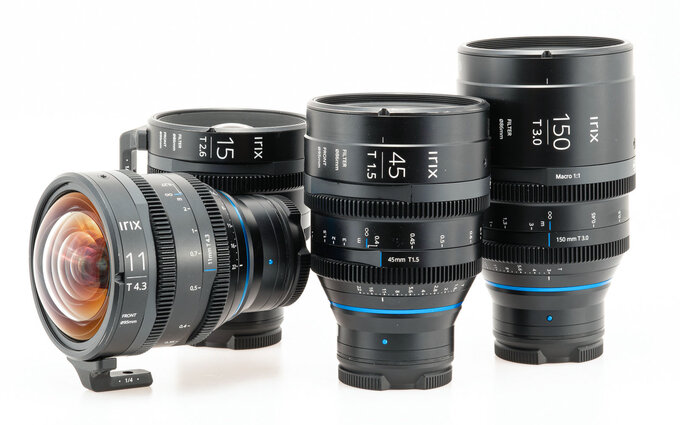Cine lenses and still photo lenses – what's the difference?
1. Cine lenses and still photo lenses – what's the difference?
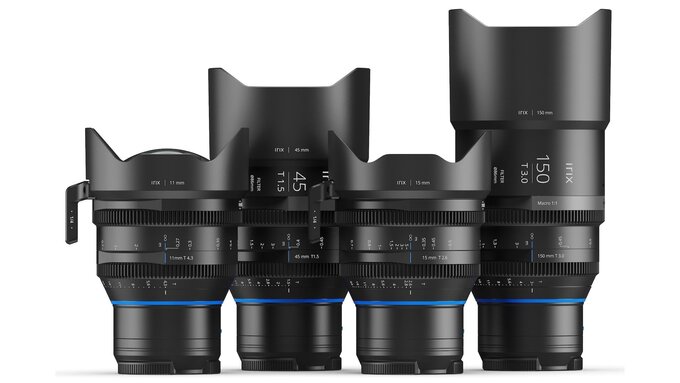 |
The first difference is easy to catch - usually, cine lenses are sold in bundles/sets. Such bundles might consist of several to more than a dozen instruments which, more often than
not, cover the most popular focal lengths. Of course still lenses are also produced in lines
or series but in their case, it is not as important as in the case of cine lenses. Why? Let
us explain.
Please Support UsIf you enjoy our reviews and articles, and you want us to continue our work please, support our website by donating through PayPal. The funds are going to be used for paying our editorial team, renting servers, and equipping our testing studio; only that way we will be able to continue providing you interesting content for free. |
- - - - - - - - - - - - - - - - - - - - - - - - - - - - - - - - - - - - - - - - - - - - - - - -
First thing: lenses from one line usually feature the same diameter (and in the case of the Irix Cine line it is a very popular 95 mm standard) and their focus and iris ring ( of course if you deal with fixed focal length lenses) are exactly in the same places and in the same distance from the mount. The lenses also tend to have the same length, but only if optical parameters allow that. It's not always possible, e.g. it would be difficult to close, say, the 11 mm T4.3 and the 150 mm T3 models in the same barrel.
Diameters of filter threads are also the same, providing that a given set of lenses supports such functionality. In the case of the Irix Cine instrument, it is possible to attach screw-on 86 mm filters or their original Magnetic Mount Ssstem which we are going to describe in more detail later.
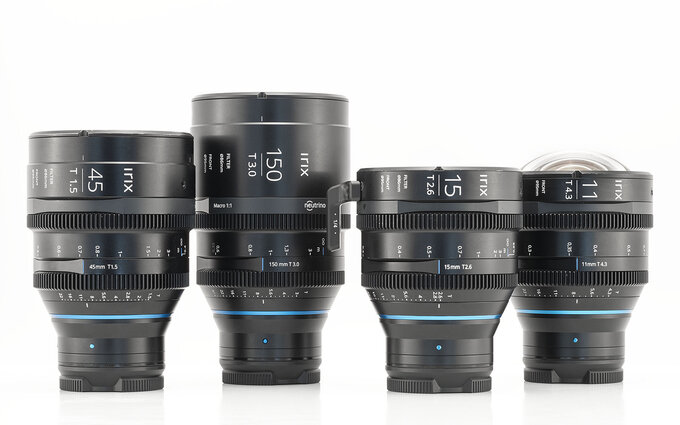
All rings on these lenses, coming from one set, are in the same position |
Identical positions of rings and the same diameter allow you to use the same filters (usually attached to a compendium but it is just one of many available options) and the same follow focus units and, perhaps, also iris control. When you have to switch the lens you don't have to move those accessories – away and then put them onto a new lens. It saves a lot of time – a very important thing when hundreds of people from your crew are waiting for you to get ready for action
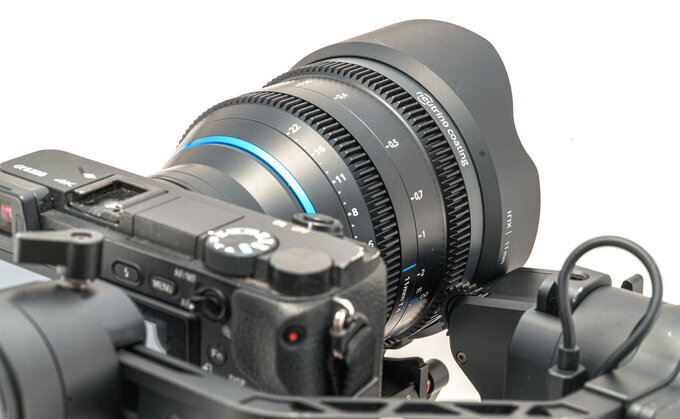
A follow focus unit attached to a cine lens |
Apart from that producers try to match anti-reflection coatings to every single lens in such a way that their coloring is as similar as possible. In the case of the Irix Cine lenses, these are their patented Neutrino Coatings.
The usage of the same coloring was very important when movies were recorded on videotape as the possibilities of color correction were rather limited. A situation when the wide background was noticeably warmer than the close-up would be a disasterdistaster. Nowadays it is no longer such a big problem but still, matching filters of different lenses make post-production much easier and in the end saves a lot of money and production time. Usually, when using photo lenses, photographers choose different brands for macro, another for a wide shot, etc. each also varies in contrast and sharpness. Those can be hard to match in post.
Focus ring
In the case of still photographic lenses the focus ring range is usually set in such a way so it allows comfort for a photographer or an operator holding the camera; when it comes to cinematic instruments the priorities are quite different. Their focus ring usually features a very large focus throw and standardized teeth compatible with follow focus units. On a professional film set there is a special person responsible for pulling focus called the 1st Assistant Camera or commonly called focus puller who makes sure the subjects are in focus. Using appropriate tools they are able to turn the ring smoothly, 'organically' so to speak, and accurately even if its focus throw is very large. The lens is supposed to make it just as simple and easy as possible.
Below you can find a focus throw of the Irix Cine, that amounts to about 270 degrees.
Apart from the wide range of the ring it is also important that ring marks reflect real distances – focus pullers often monitor not only the display but also consult a tape measure, markers positioned on the floor for the actors, and other solutions from the past, when only the camera operator assistant, responsible for leading a camera, had an access to distance values.
In the case of the Irix Cine line the producers applied UV-sensitive paint to mark the rings and it improves their visibility at night. Also, because of them the workstation of the focus puller is easier to illuminate without making it noticeable in the camera.
Focus breathing
Setting focus during video recording is connected to so-called 'breathing'; it is a change of frame content during focusing. As it is not important in still photography, in case of movie shooting it might be considered a grave mistake as it can distract your audience and taking them out of the story. Cinema lenses are designed in such a way that they try to limit that effect as much as possible.
Iris ring
An iris ring in cine lenses is an equivalent of an aperture ring in photo lenses. It is clickless and it features a standardized toothed gear. What's its practical usage? It sometimes happen that during some shots the exposition changes so much that you have to readjust iris values. If you do it smoothly and skillfully such changes will pass unnoticed for the audience.
Such shots usually involve camera movements so the device has to be attached to a steadicam or another camera stabilizer like a crane; in such cases it would be good to control the iris ring remotely, with a system similar to the follow focus. When it comes to zoom lenses there can be as many as three such motors in place.
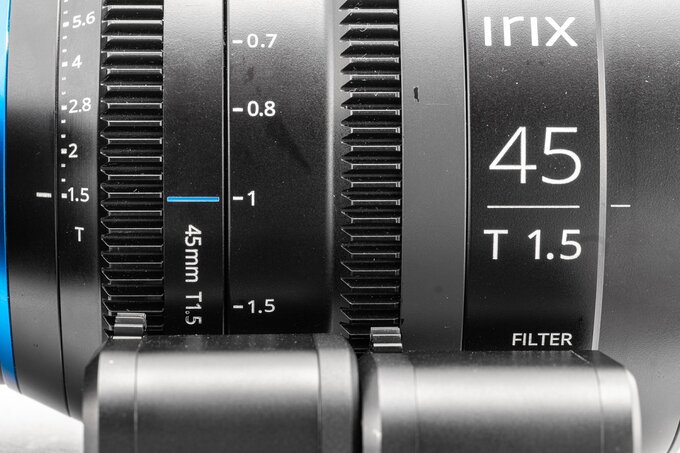
Separate remote control for iris and focus |
An attentive observer is able to notice another difference. The iris ring of a cine lens (like the lens itself) is described not in terms of focal ratio ('f) but transmission ('T'). What's the difference? In simple terms a T2 cine lens allows inside as much light as an f/2 still lens if it featured perfect glass and ideal anti-reflection coatings. Of course in reality neither glass nor coatings are perfect so quite often the transmission value is a bit different than its respective aperture value and that difference is easy to spot – it's enough you compare cine lenses and their still equivalents. In the case of the Irix 45 mm T1.5 Cine it would be the 45 mm f/1.4 still lens and in case of the 150 mm T3.0 Cine device – the 150 mm f/2.8 photographic lens.
Still, why do you need to trouble yourself with such comparisons? From the exposition's point of view transmission values happen to be more precise. Every cinematic lens set at a given value will let exactly so much light, no matter how many elements it has inside or what quality its coatings are. In times of analog video cameras it helped to develop the videotape in a proper way but also today it makes work of people responsible for colour correction easier. Especially since often lens has to be changed for close up or wide shot, having the same exposure helps preserve that cinematic magic.
In order to demonstrate the functionality of transmission marking in practice we recorded a colour pattern using all Cine Irix lenses that we set at the same transmission value. As you can notice, their iris rings are labelled correctly precisely.
Construction
The last important aspect of a cinema lens is its overall sturdiness. Of course you can say that the same requirements concern, say, professional still lenses for photojournalists but cine lenses additionally don't have to be that small. A producer can add to their bulk in order to make them even more indestructible – an accidental collision with a door frame won't force you to call a break and sweep glass shards from the floor. The weight also helps to balance the camera on gimbal, shoulder rig or tripod. Since often cine cameras are much bigger than photo cameras, having a heavier front helps offsetting the weight of camera and battery.

A comparison between a cine lens and the Sigma 35 mm f/1.4 DG HSM Art, often used in our tests as a reference point |
Of course a solid barrel means also a solid increase in weight so many cine lenses also feature screw-on brackets or a foot that allow you to attach it to a rig in a steady way, that will help in taking off some weight from the mount.
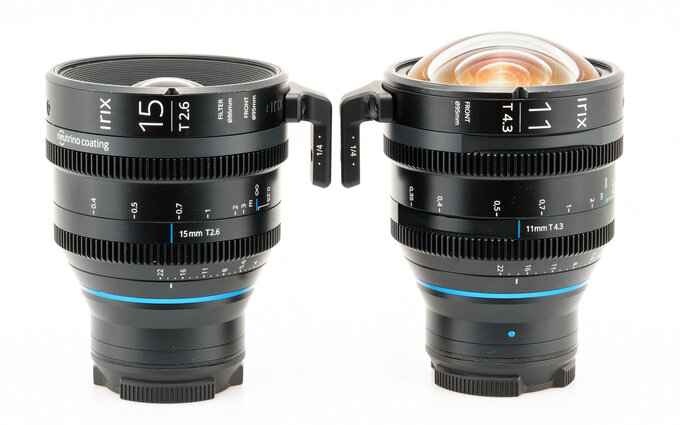
Additional lens support foot allow you to fix it to a camera and make them sturdier |
Irix Cine lenses, described in this text, are a sensible compromise between sturdiness and weight. On the one hand their build quality is beyond reproach, on the other hand none of these beauties weighs more than 1200 g, a fact that makes them a truly lightweight set of lenses for cinema standards.
Irix Cine Line
Irix Cine lenses, presented in this article, are a set of quite untypical instruments. All of them feature full frame sensors while offering quite original parameters such as 11 mm T4.3 or 150 mm T3.0 Macro. They are also very sensibly priced for such lenses – professional cinema constructions from such companies as Zeiss or Cooke can cost more than a dozen or even several dozen thousand dollars...a piece.
Other innovative solutions, the trademark of Irix, are also worth your attention, like these magnetic filter and hood mounts, presented below.
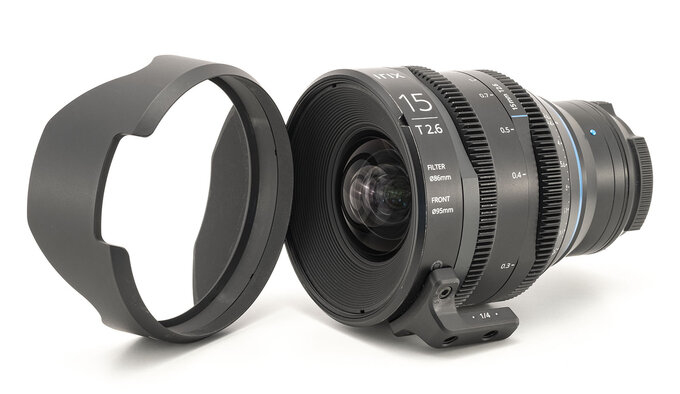 |
The superior speed of work is an unquestionable asset of magnetic solutions – the swap of filters takes as short, if not shorter, than shifting the compendium while you swap the lens. On the other hand a magnetic mount hood is able to substitute for a compendium easily. By the way, it is a perfect fit for the focal length of a given instrument so you don't need to adjust any parameters.
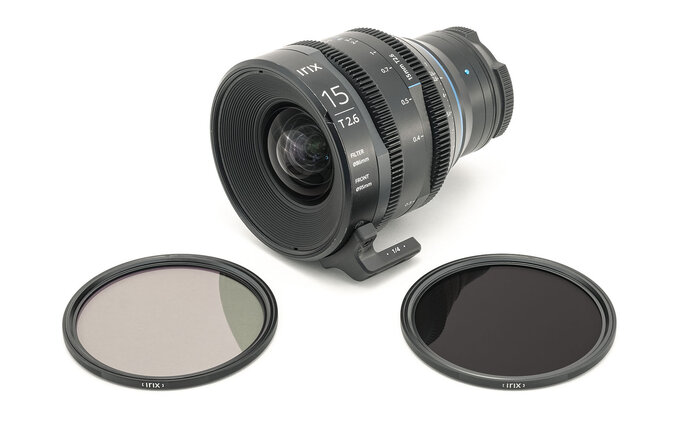 |
Finally you should mention the fact that without any problems you can buy magnetic versions of the most popular cinema filters, such as polarizers, neutral density filters (available in densities: ND4, ND8, ND16, ND32 or ND64) or UV filters. Their diameters of course fit the diameters of the lenses.
 |
This article was comissioned by Next77, the Polish distributor of the Irix brand name.




